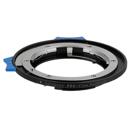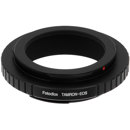
Fotodiox Pro Lens Mount Adapter for Miranda (MIR) SLR Lens to Canon EOS (EF, EF-S) Mount D/SLR Camera Body, with Generation v10 Focus Confirmation Chip
SKU: FDMIREPFC10
This item is no longer available.
Recommended Alternatives
Share:
Overview
Compare
Specs
Protection
Q&A
Questions & Answers
Reviews about this item
Review Summary
Select a plan in the Add Protection section above and purchase with this product by clicking “Add to Cart”.
TRUSTED PROTECTION PLANS, EXCEPTIONAL SERVICE.
Invest In Your Gear and Peace Of Mind!
Accidents happen. Protect your favorite Adorama products and purchase a protection plan to stay covered from accidental damage, mechanical or electrical failures, and more.
Repair or Replacement
If we can’t fix it, we’ll replace it at no additional cost.
Accidental Damage
Protect your product from drops, spills, and more.
Peace of Mind
Enjoy your gear without fear. We have you covered!
Failure Protection
When regular use of your product over time results in mechanical or electrical failure.
Zero Deductible
We will never charge you a deductible after the purchase of a plan.
Customer-Focused Support
Our claims process is simple & easy and our customer service team is happy to help.
Adorama Protect powered by Extend is available for purchase to customers in the United States. Not available for international or U.S. territories purchases. Plans on open box items do not cover pre-existing damage.
Adorama Protect plans are available for ABS clients. If you have any questions or require assistanse, please call 800-223-2500
Browse our FAQ
Fotodiox Pro Lens Mount Adapter for Miranda SLR Lens to Canon EF, EF-S Camera Specifications
Material
Brass, Metal
Compatibility
Canon EOS (EF, EF-S) Mount Camera Compatibility - Popular models include:
5D Mk IV / 1Ds / 1Ds Mk II / 1Ds Mk III / 1D X / 1D X Mk II
5D / 5D Mk II / 5D Mrk III / 6D - Firmware v1.3.3 (later versions not tested)
40D / 50D / 60D / 70D / 80D / 77D / 6D Mk II / 7D / 7D Mk II - Firmware v1.0.3 (later versions not tested)
100D / 200D / 350D / 400D / 450D / 500D / 600D / 650D / 700D / 750D / 760D / 800D / 1200D / 1300D - Firmware v1.0.3 (later versions not tested)Lens Mount
Miranda (MIR) SLR Lens
Body Mount
Canon EOS (EF, EF-S) Mount D/SLR Camera
UPC Code
847372046072
About Fotodiox Pro Lens Mount Adapter for Miranda SLR Lens to Canon EF, EF-S Camera
Mount Vintage Lenses to Canon EOS Cameras
Whether you're shooting digitally or on film, Fotodiox offers the world's largest selection of lens adapters. Mix camera/lens platforms or reinvigorate vintage glass; Fotodiox has hundreds of ways to mount lenses onto your DSLR or SLR camera. Our adapters deliver infinity focus and a sturdy build for lasting quality. From standard to portrait, tilt/shift to wide angle - Fotodiox adapters are designed to offer an inexpensive system that enables you to choose from a vast range of lenses to better suit your needs.
Generation v10 Focus Confirmation Chips
One of the problems of using manual focus lenses on Canon EOS bodies is that focus confirmation is disabled. When AF lenses are used - even in manual focus mode - all Canon EOS bodies confirm focus with a green dot in the viewfinder and an (optional) audible beep. However when non-EF compatible lenses are used via an adapter, the focus confirmation is disabled. Unless the camera thinks that an EF compatible lens is attached to it, it switches off both visual and audible focus indication.
Focus confirmation chips 'trick' the Canon EOS body into thinking an EF lens was attached, so that the focus confirmation indicators work with any lens attached. Focus confirmation chips are great because:
• Without live focus, all that is available is a smooth dim viewfinder
• Even with live focus screen it's really hard to see when focus is properly achieved on the subject you want.
Those old split prism viewfinders made a huge difference when focusing, kind of like your own phase detect focusing system.
High-Tolerance Precision Craftsmanship
The leaf spring design in the adapter holds the lens tight to the adapter, mimicking the leaf springs in the camera body, ensuring there is no play between the camera and the lens. The all metal design and polished surface are designed to guarantee a smooth mounting experience for years to come. The depth of the adapters are designed to take into account the differences in focal flange distances between the lens and camera ensuring that all lenses, both brand name and third party, will focus at least to infinity (if not slightly past).
All-Metal Design & Construction
Fotodiox Pro adapters are designed with tight tolerances to create a solid, gap free, no play, no wiggle connection with no adjustments ever needed.
Note:
• This is a manual adapter, so lens functions that rely on electronic communication with the camera body (autofocus, AE metering, image stabilization, etc.) will be disrupted.
• Set your exposure manually or meter using your camera's Aperture Priority (stop-down) mode.
• If your lens does not have a manual aperture control ring, the lens aperture will revert to its default position, which depending on the lens is either stopped down to its largest f-stop or opened up to its smallest f-stop.
Fotodiox Pro Lens Mount Adapter for Miranda SLR Lens to Canon EF, EF-S Camera Features
- Mounts a Vast Range of Vintage Workhorse Lenses to Canon EOS (EF, EF-S) Mount D/SLR Cameras
- Upgraded and Enhanced, Generation v10 Focus Confirmation Chips for Increased Compatibility
- Enhanced craftsmanship and high-tolerance construction for demanding professionals; Infinity Focus or Beyond Guaranteed
- Precise fit and solid all-metal construction with chrome plated brass mounts for secure and solid fit; lens has no play, gap or wiggling when mounted on adapter and no adjustments required
Key Features
- Mounts a Vast Range of Vintage Workhorse Lenses to Canon EOS (EF, EF-S) Mount D/SLR Cameras
- Upgraded and Enhanced, Generation v10 Focus Confirmation Chips for Increased Compatibility
What's in the box:
- Pro Lens Mount Adapter
- Fotodiox 2 Year Limited Warranty

